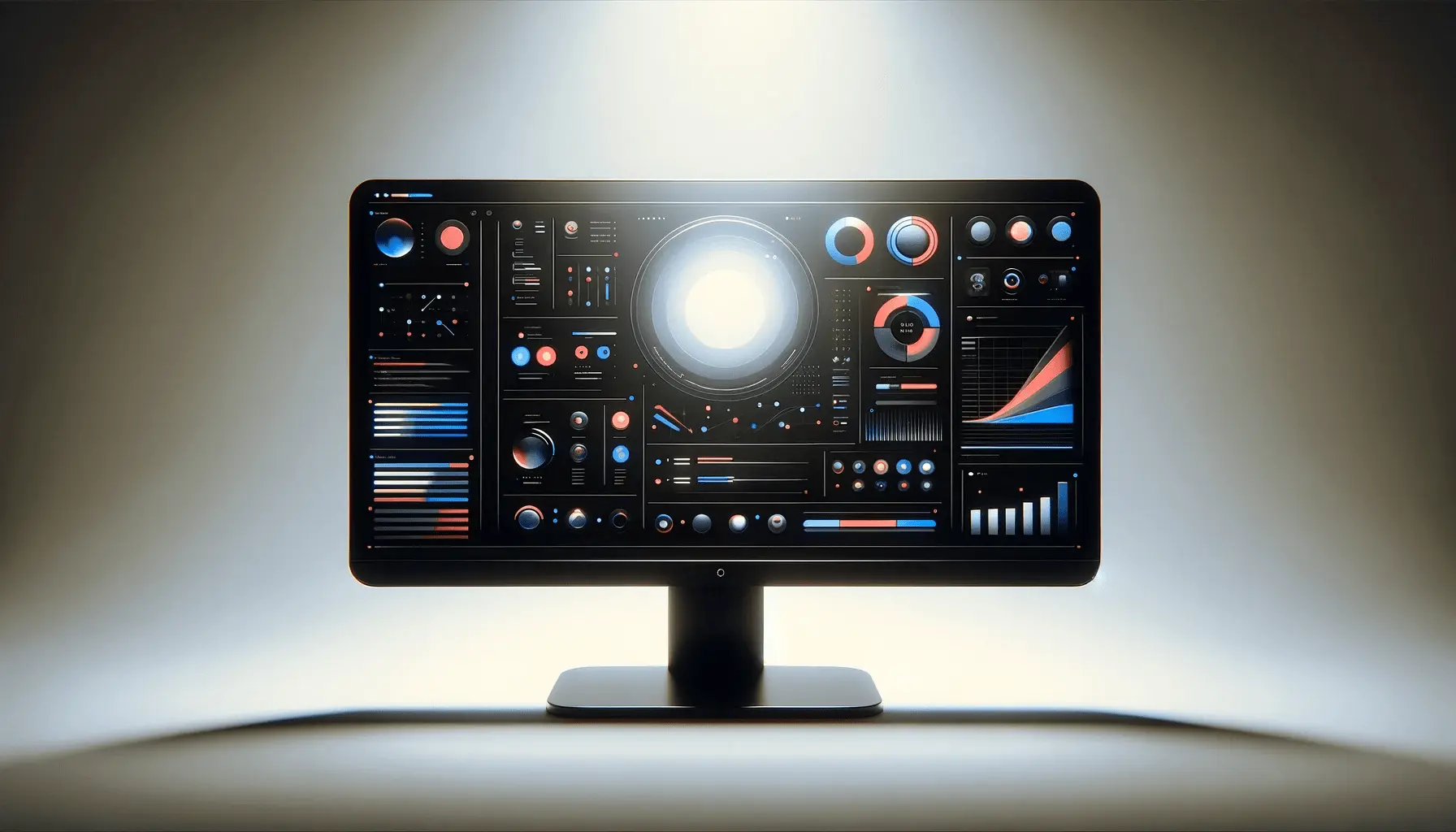In today’s fast-paced digital world, your website has just seconds to make an impression.
But what happens when it tries to do too much?
That’s where the concept of overstimulationOverstimulation refers to a state where too many sensory inputs overwhelm a person's ability to process information effectively. comes into play.
In web design, overstimulation occurs when a website overwhelms visitors with excessive visuals, animations, colors, and content.
It’s like walking into a room full of flashing lights and loud noises—you want to leave immediately.
This article explores how overstimulation impacts user experience and how you can design with balance, clarity, and purpose to engage your visitors, not exhaust them.
- Understanding Overstimulation in Web Design
- Big Causes of Overstimulation on Websites
- Design Principles for Avoiding Overstimulation
- Tools and Techniques for Balanced Web Design
- Real-World Examples and Case Studies
- Finding Balance: A Way Out of Overstimulation
- Frequently Asked Questions Regarding Overstimulation in Web Design
Understanding Overstimulation in Web Design
Let’s start at the beginning.
Overstimulation in web design is when a user experience is one in which too many things compete for attention at once.
It’s when a site becomes so cluttered with features that it is brain-draining to navigate through.
The goal of an amazing site is to guide the user organically, but when each corner and crevice on the page is yelling for attention, visitors are confused and drop out.
What is overstimulation in a digital context?
Overstimulation is when a user’s senses are overwhelmed by an excess of inputs.
In a digital context, these include:
- Too many calls-to-action or pop-ups at once
- Overwhelming, clashing color palettes that strain the eyes
- Busy layouts with little or no white space
- Auto-playing videos, background animations, and loud audio
When you combine all these in one spot, your website is no longer informative but anxiety-provoking.
Overstimulation ruins the user experience by making the interface too chaotic to enjoy.
The psychology of sensory overload online
Our brains are conditioned to filter out information efficiently.
But when presented with too many competing stimuli simultaneously, the brain tires.
This leads to decision paralysis and frustration among users.
Users might click away just because they have no clue where to start.
Overstimulation isn’t just frustrating—it’s draining on a psychic level and disrupts how we interact with websites.
How web design causes cognitive fatigue
Cognitive fatigue sets in when users must work too hard to accomplish what they want to do.
If your menu is complicated, if your home page has five sliders, and if every section struggles to be seen, users grow tired fast.
Simple design decisions can prevent overstimulation.
Approach your site as a conversation, not a sales page.
Give your user some breathing room and a clear path to follow.
Common signs of overstimulating interfaces
Not sure if your site is a victim of overstimulation?
Watch out for these signs:
- Bounce rates are high and engagement times are low
- Ongoing user complaints of “confusing” or “busy” layout
- Difficulty getting traffic to key CTAs
- Too many competing items above the fold
If you see these patterns, it’s time to pull back and simplify.
Keep in mind: a peaceful, intuitive design welcomes users to linger longer, go deeper, and convert better.
Reducing overstimulation is key to creating an enjoyable and productive web experience.
Overstimulation in web design distracts users and creates frustration. A cluttered interface disrupts natural user flow and increases drop-off rates.
Big Causes of Overstimulation on Websites
So what does lead to overstimulation in web design, then?
If you’ve ever visited a site that had your eyes racing around everywhere or left you stumped about where to click, you’ve witnessed it occur.
Too many sites these days are guilty of attempting to do too much at once, and that creates chaos for the user.
When you’re designing a site, it’s simple to get caught up.
You want it to be new, fun, and interesting—but watch out, because if you don’t, you’ll be confusing your visitors instead of amazing them.
Too much use of animations and transitions
Animations can bring a site to life, but too many of them are one of the major culprits of overstimulation.
Nagging hover effects, scrolling effects, or bouncy, rotating, and disappearing objects distract rather than delight.
Visitors to your site are likely expecting simplicity, not an online circus.
Too many animations will slow down the loading of a page and annoy users trying to accomplish simple tasks.
Too much color and visual clutter
Color is powerful on the web, but using too many vying colors is visual clutter.
When every button is highlighted and every background is demanding attention, your message is lost.
Overstimulation starts with a visually over-burdened palette.
- Use a minimal color palette
- Choose complementary colors
- Direct attention with contrast, not chaos
- Create a soothing, unified look
Busy navigation and layout issues
When your site is full of too many menu choices, dropdowns, sidebars, and widgets, your visitors are confused.
Cluttered design causes overstimulation by bombarding your visitors with too many choices at once.
It causes visitors to think that they are on a treasure hunt instead of a plain browsing adventure.
- Simplify navigation for clarity
- Place similar pages into categories
- Reduce menu levels where possible
- Use mega menus only when truly needed
Autoplay videos and pop-up intrusions
We’ve all been there—a page loads and suddenly a video blares at full volume or a pop-up covers the entire screen.
These tactics may seem engaging, but they often backfire.
Overstimulation increases when users are forced to close distractions before they even start exploring.
- Use autoplay features sparingly
- Trigger pop-ups with thoughtful timing
- Consider exit intent or timed engagement triggers
In a world of online, your first impression is everything, and avoiding these overstimulation cues can make your site stand out—for all the best reasons.
Ask yourself: are you guiding your visitors along a path, or are you confusing them?
Achieving balance means being intentional about each and every thing you introduce.
Less noise, more focus—that’s the goal.
Trying to impress users with excessive features often backfires. Complex animations, chaotic colors, and overloaded layouts are major contributors to user fatigue.
Design Principles for Avoiding Overstimulation
If your site seems to be screaming at your users, maybe it’s time to dial back the volume.
Avoiding overstimulation begins with careful, user-focused design.
The intention isn’t to make your site dull—it’s to make it simple to use, pleasant to explore, and effective in function.
When visitors are comfortable and in command, they’re much more likely to linger.
Take a glance at some design concepts that will help you create a harmonious and welcoming web experience.
Embracing minimalist and clean designs
Minimalism isn’t a fleeting trend—it’s a proven means of reducing overstimulation.
Clean designs with plenty of breathing space allow the user to focus on what’s truly significant.
Avoid what is insignificant and noisy.
When every element of your site has a purpose, the user can smoothly move from point to point without becoming bogged down.
- Trim the amount of items on every page
- Remove everything that doesn’t serve a definite purpose
- Use a grid system to construct structured, harmonious compositions
Using whitespace to create focus
Whitespace—alternatively known as negative space—is one of your greatest allies in the fight against overstimulation.
It guides the eye of the user, separates elements, and provides visual relief.
When used effectively, whitespace makes your design feel spacious, more relaxed, and focused.
- Leave room between blocks and sections of text
- Don’t overcrowd things in every nook and cranny of the screen
- Highlight key content by leaving space around it
Limiting the number of colors used and the choice of fonts
Consistency is the most important thing.
A sophisticated color scheme and two or three highly selected fonts make people feel grounded when they’re navigating your site.
It reduces visual noise and helps with brand recognition without overwhelming the senses.
Multiple fonts or flashy, jarring colors are overstimulating and make your site look chaotic.
- Use no more than three font types on your entire site
- Choose a color scheme of 2–4 complementary colors
- Apply accent colors sparingly to draw attention to areas
Clear content hierarchy
Users employ visual cues to determine what is most important.
A clear content hierarchy maintains your structure tidy and self-evident.
A clear hierarchy tells users where to look first and what to do next, avoiding overstimulation and confusion.
- Use headings, subheadings, and bullets for structuring
- Highlight important calls-to-action with strong contrast
- Make sure your most important content is easily findable
Creating a more seamless user experience with peaceful interactions
All interactions on your site should be smooth and intentional.
Smooth transitions, consistent animation, and adaptive feedback all contribute to a calmer experience.
Well-executed interaction design avoids overstimulation and creates a more usable space.
- Shorten transitions and make them natural
- Use animation to support—not battle—content
- Ensure buttons and links react crisply to user input
By following these principles, you create a web environment that supports your message without overstimulating your audience.
Overstimulation can be subtle, but its potential is enormous.
Be serene, concentrated, and deliberate—your visitors will thank you.
Designing with simplicity, intentional whitespace, and a focused content hierarchy fosters clarity and calm. Aim for usability over decoration.
Tools and Techniques for Balanced Web Design
Creating a site that is resistant to overstimulation isn’t just about having good intentions—it’s about using the right tools and techniques to build with intention and simplicity.
From research to planning layout and accessibility audits, the web design process offers many opportunities to prevent sensory overload.
Whether you’re building a new site from scratch or enhancing an existing website, the following tools and techniques will help you build a user experience that is centered, inclusive, and accessible.
Applying UX research to guide design decisions
Start with user experience (UXUX stands for User Experience, which refers to the overall experience a user has when interacting with a website or application.) research prior to writing a single line of code or putting things on a page.
Understanding how users feel about your site avoids overstimulation by keeping design decisions in sync with what actually works.
By asking questions through surveys, interviews, and usability testing, you can identify pain points, confusing functionality, and unnecessary elements.
- Utilize usability tests to reveal real-time frustrations
- Utilize heatmaps to track user focus and navigation patterns
- Collect feedback to refine content and layout choices
Strengthening accessibility recommendations
Accessible design not only increases inclusivity—it also helps minimize overstimulation.
By following guidelines like the WCAGWCAG stands for Web Content Accessibility Guidelines, a set of recommendations for making web content more accessible, especially to people with disabilities. (Web Content Accessibility Guidelines), you create a clearer, simpler-to-read experience for all.
Accessibility-driven simplicity benefits overall usability.
- Ensure sufficient color contrast between text and background
- Make use of alt text on images to support screen reader navigation
- Restrict content movement and flashing to prevent harm to users who have sensory sensitivities
Checking designs with heatmaps and user feedback
Heatmaps and recordings of user sessions are excellent resources for discovering visual clutter.
They indicate precisely where users click, scroll, or stall—offering direct evidence of overstimulation areas.
If users steer clear of particular sections or miss critical CTAsCTA stands for Call to Action, a prompt on a website designed to encourage user interaction, like a button or link., the design may need to be streamlined.
- Utilize software such as Hotjar, Crazy Egg, or Microsoft Clarity
- Seek patterns in behavior to inform design changes
- Combine heatmap data with direct user feedback for deeper insight
Applying contrast and readability principles
Contrast and readability are crucial to reducing overstimulation.
Clean typography, consistent spacing, and color consistency keep things visually under control.
You want your content to be easy on the eyes and effortless to navigate.
- Choose readable font sizes and line heights
- Avoid excessive use of bold, italic, or underlined text
- Apply contrast to highlight—not overwhelm—key elements
Leveraging wireframes and prototypes for clarity
Wireframes and prototypes allow you to prototype structure without distraction prior to launching your live design.
They eliminate clutter and allow you to visualize flow, function, and layout.
This early clarity helps prevent overstimulation from creeping into the final product.
- Design low-fidelity wireframes to determine major content blocks
- Test user flows with interactive mockups
- Gather feedback before adding visual design
With the right tools, web design isn’t just easier—it’s smarter.
With research, testing, and deliberate planning, you can build digital places that are calm, logical, and enjoyable.
Overstimulation doesn’t stand a chance when your process is driven by user needs and supported by data.
Utilize UX research, heatmapsHeatmaps are graphical representations of data showing where users click, scroll, or interact the most on a webpage., and accessibility audits to make informed design decisions. These tools help detect overstimulation and guide smoother user experiences.
Real-World Examples and Case Studies
There are times when the best learning comes from viewing real-world examples.
Studying successful sites handling visual complexity leads to more empathetic design decisions.
Alternatively, studying failure where others tripped up saves you from the same misstep.
In this case, we’re going to cover good and bad examples of web design—and zoom in on what can be learned about avoiding overstimulation.
Sites that successfully reduce overstimulation
Some of the most utilized and available sites on the internet are masters at simplicity, cleanliness, and functionality.
They utilize whitespace, nice color schemes, and rational navigation to create a calming experience.
- Apple: Well known for its clean style, Apple’s website uses enormous images, simple layouts, and concise messaging. Despite being full of images, it never overpowers or causes overstimulation.
- Dropbox: Dropbox combines whimsical graphics with ample negative space to maintain the user’s focus on the message and not on distraction.
- Medium: This publishing platform uses a restricted color palette, ample space, and strong typography to maximize readability and reduce overstimulation.
Redesigns that reduced user fatigue
Some well-established brands have redesigned their online interactions to battle overstimulation.
Streamlining their UI and user-first focus, they’ve seen gains in satisfaction and engagement.
- Spotify: Spotify’s redesign introduced whitespace, minimized clutter, and improved navigation with better visual hierarchy. The result? A clean experience where the user’s likes and playlists are featured.
- eBay: A site that was once notorious for a chaotic and messy interface, eBay transitioned gradually to a cleaner interface with more consistent colors, less competing elements, and prioritizing personal content.
Lessons gleaned from the design choices of heavy-traffic websites
Heavy-traffic websites like Amazon and YouTube must deliver considerable amounts of content without overloading users.
Their design choices exemplify that even complex websites can reduce overstimulation by employing smart structuring.
- Amazon: While content-heavy, Amazon leverages straightforward categorization, collapsible content, and a comfortable layout to ensure an effortless user experience.
- YouTube: YouTube’s use of grid layouts, visual grouping, and personalized recommendations helps to direct user focus between a thousand or so videos.
Brand consistency vs visual noise
Branding is essential, but too much visual stimuli competing for the user’s attention can be an overstimulus.
Effective brands balance identity with restraint—giving their message a loud, clear voice without being so loud that it is confusing.
- Use your brand color and typography consistently, but selectively
- Emphasize one or two solid visual features per page
- Let your content—not your branding—define the experience
Trends that are shaping calmer digital spaces
Design trends are moving toward simplicity and clarity increasingly.
Since users increasingly demand more streamlined experiences, designers are adopting approaches that minimize overstimulation and optimize usability.
- Dark mode: Provides visual relief, reduces glare, and improves focus, especially when viewing at night
- Neumorphism and soft UI: Focus on light shadows and subdued color to create a clean, haptic feel
- Microinteractions: Tiny, thoughtful animations that guide users without overwhelming them
Learning from the world outside reminds us sometimes less is more.
Whether it’s a global technology giant or a small blog, reducing overstimulation produces a better, more memorable user experience.
Remain focused, remain intentional—and design for simplicity in the process.
Sites like Apple and Medium prove that simplicity scales. Analyzing real-world designs reveals that calm, consistent layouts win over chaotic ones.
Finding Balance: A Way Out of Overstimulation
Why Treating Overstimulation in Web Design is Important
In a digital age of motion, color, and content, users crave simplicity.
Overstimulation is more than just a design issue—it directly affects usability, engagement, and conversion.
A site that overstimulates instead of directs will repel users, no matter how beautiful the visual may be.
That’s why fighting overstimulation is not just good—it’s essential to creating successful digital experiences.
Key Takeaways from This Guide
Throughout this post, we’ve explored the theory of overstimulation in all its facets.
Whether you’re starting from scratch or refining a current web presence, here are the things to keep in mind:
- Know the sources: Disorganized layouts, excessive animations, and poor content hierarchy will typically lead to overstimulation.
- Design purposefully: Focused doesn’t mean bland—it means goal-directed, people-directed, purposeful design.
- Use the right tools: UX research, accessibility testing, and usability testing can spot points that contribute to sensory overload.
- Learn from success: Both success and failure are educational about what works and what doesn’t.
Practical Tips to Stay Ahead of Overstimulation
Want to use this in practice?
Here are a few actions you can start taking today to build calmer and more effective websites:
- Audit your existing site for visual clutter and streamline where possible.
- Create a strong visual hierarchy with size, space, and color.
- Use 2–4 brand colors and adhere to them consistently.
- Minimize font usage and avoid unnecessary stylistic treatments.
- Test designs early with prototypes, user testing, and heatmaps.
Creating a Future-Ready Web Experience
As digital environments evolve, users will increasingly seek out experiences that are intuitive, transparent, and emotionally calming.
Overstimulation is a roadblock—but also an opportunity.
It pushes designers to slow down, think critically, and simplify.
The best sites aren’t the loudest—they’re the ones that speak clearly and confidently to their audience.
By focusing on what truly matters and designing with empathy, you ensure your site is not only beautiful—it’s usable, memorable, and meaningful.
The path away from overstimulation starts with one simple choice: prioritize your users.
Balance is not about removing creativity—it’s about directing it. Design with purpose and empathy to guide users toward meaningful engagement.
Quality web design is key for a great website! Check out our service page to partner with an expert web design agency.
Frequently Asked Questions Regarding Overstimulation in Web Design
Below are some of the most frequently asked questions regarding efforts to comprehend and deal with overstimulation in web design.
These short answers will help clarify key concepts and provide practical advice.
Overstimulation in web design occurs when an excess of visible or interactive elements floods users and makes it hard to concentrate, move around, or interact effectively with the site.
Overstimulation can cause user frustration, mental fatigue, and higher bounce rates through an overwhelming amount of information or visual complexity presented all at once to visitors.
Signs include too much animation, poorly organized layout, intrusive color palette, confused navigation, and an excessive number of pop-ups or distracting calls-to-action on every page.
Optimize for clean design layouts, reliable color schemes, apparent hierarchy, small animations, and user-empowering principles in order to instill peace of mind along with engagement.
Not necessarily, though it usually comes to the rescue.
It’s more about judicious design—removing what’s unnecessary while maintaining a site that’s visually strong, usable, and focused to reduce overstimulation.
Yes, overstimulation may distract or even harm users with sensory sensitivities.
Accessible design naturally reduces overstimulation and improves usability for everyone.
Heatmaps, session recordings, user testing tools, and accessibility checkers may all be used to detect friction points and overstimulation in your web design.
In most cases, yes.
Dark mode can reduce visual strain and provide a more focused, intimate environment—especially in low-light or long-term use conditions.
Yes.
Too much brand color, typography, or visual effects can interfere with users.
Branding must support the message—not visually battle it and contribute to overstimulation.











